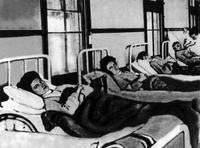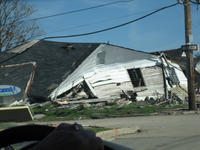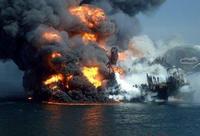-
Making buildings more tsunamis-resilient
Often in disasters such as tsunamis, people escape the on-rushing wall of water by climbing to higher ground, called vertical evacuation. As people race to the third or fourth floor of a building, however, how do they know whether the building will hold up? Walls of water often carry with them cars, trucks, and 60,000-pound fully loaded cargo containers, transforming them into projectiles which slam into buildings with tremendous force. Most structural systems are designed to defy gravity, not a side kick from a shipping container. Engineers are now studying the impact of tsunami-carried debris in order to make buildings and other structures more disaster-resilient.
-
-
U.K. revises nuke emergency plans post-Fukushima
The Sizewell nuclear power station in Suffolk, England, was decommissioned in 2006, but after the 2011 Fukushima disaster, the Suffolk authorities thought there was a need to upgrade the emergency plans for the people living around the plant. There are disagreements, however, over the radius of the emergency zone around the plant, and how many people should be included i evacuation plans and given potassium iodide tablets in the event of a radiation leak.
-
-
Why typhoid fever pathogen targets only humans

Salmonella typhiis a particularly nasty bacterium that targets only humans and causes typhoid fever, which kills hundreds of thousands of people annually; scientists explain how evolution shaped the pathogen to be so selective
-
-
Keystone XL pipeline: reliability of remote oil-spill sensors questioned
The oil industry plans to build thousands of miles of pipelines in the next five years, making leak detection a growing issue; many of the new pipelines will cross aquifers and rivers which are used for drinking water and irrigation; the Keystone XL pipeline has already experienced its share of controversies, and now there is a debate over the quality and reliability of the pipeline’s sensor system for remote detection of oil spills
-
-
At least 200,000 tons of oil, gas from Deepwater Horizon spill consumed by bacteria

Researchers have found that, over a period of five months following the disastrous 2010 Deepwater Horizon explosion and oil spill, naturally occurring bacteria which exist in the Gulf of Mexico consumed and removed at least 200,000 tons of oil and natural gas that spewed into the deep Gulf from the ruptured well head
-
-
The spring 2010 BP oil disaster could have been prevented: expert
The BP oil disaster in the Gulf of Mexico during the spring of 2010 could have been prevented if the experiences of earlier disasters had been put to use, an expert claims; the U.S. government is now accusing BP of gross negligence and deliberate misconduct, and taking the company to court
-
-
Top 5 critical hurricane preparedness actions

The National Center for Disaster Preparedness (NCDP) at Columbia University reminds Americans that hurricane preparedness lasts all season — from June to November — and that emergency preparedness is a year-round proposition, because emergencies do not have a season
-
-
Hospital-based disaster preparedness center opens in Utah
A 7,000 square-foot disaster preparedness center opened in Salt Lake City; the center is a fully-equipped environment with eighteen patient rooms, medical training mannequins, training classrooms, disaster simulation labs, and a secure supply area; the key is that the preparedness training is done in a working environment
-
-
Steps organizations should take to prepare for disasters
Even if your company has not been affected by tornados, tsunami waves, or wildfires, all employers need to be prepared for the mayhem that natural disasters cause
-
-
Scientists: Deepwater Horizon exposed gaps in deepwater oil spill knowledge

On the second anniversary of the Deepwater Horizon oil spill in the Gulf of Mexico, a national team of scientists warns that inadequate knowledge about the effects of deepwater oil well blowouts threatens scientists’ ability to help manage comparable future events
-
-
Chinese monopoly on rare Earth metals a challenge for green economy
In order for clean technologies to contribute significantly to reducing greenhouse gases, the world would require an increase of neodymium and dysprosium – two of the seventeen rare Earth elements — of over 700 percent and 2,600 percent, respectively, in the next twenty-five years; the supply of these metals is currently increasing at 6 percent a year, and is under threat from China
-
-
The bicycle's next frontier: disaster response

Cities in seismically active regions are examining their emergency response policies in the wake of the March 2011 tsunami in Japan; the city of Portland, Oregon, as well as citizen-led Neighborhood Emergency Teams(NET), have been including the cargo bike in their emergency response plans
-
-
Haiti implements national plan for disaster risk reduction
The government of Haiti and the UN Development Program launch Haiti’s National System for Disaster Risk Reduction program; the UN says this is one of the first times that a developing country has taken advance measures to reduce the vulnerability of its people and economy to future earthquakes
-
-
Better policies needed to reduce radiation exposure in nuclear accidents
A new study says that offsite policies and plans should be put in place to reduce the exposure of the public to radiation in the event of a nuclear power plant accident
-
-
If Japan-like disaster happened in U.S., results would be far worse
An estimated 20,000 people died or are still missing after a massive earthquake-induced tsunami struck Japan on 11 March 2011, yet some 200,000 people were in the inundation zone at the time; experts say that if the same magnitude earthquake and tsunami hits the Pacific Northwest, the death toll will be much higher because of the lack of comparable preparation; that 90 percent rate could be the number of victims, not survivors
-
- All
- Regional
- Water
- Biometrics
- Borders/Immig
- Business
- Cybersecurity
- Detection
- Disasters
- Government
- Infrastructure
- International
- Public health
- Public Safety
- Communication interoperabillity
- Emergency services
- Emergency medical services
- Fire
- First response
- IEDs
- Law Enforcement
- Law Enforcement Technology
- Military technology
- Nonlethal weapons
- Nuclear weapons
- Personal protection equipment
- Police
- Notification /alert systems
- Situational awareness
- Weapons systems
- Sci-Tech
- Sector Reports
- Surveillance
- Transportation
Advertising & Marketing: advertise@newswirepubs.com
Editorial: editor@newswirepubs.com
General: info@newswirepubs.com
2010-2011 © News Wire Publications, LLC News Wire Publications, LLC
220 Old Country Road | Suite 200 | Mineola | New York | 11501
Permissions and Policies
Editorial: editor@newswirepubs.com
General: info@newswirepubs.com
2010-2011 © News Wire Publications, LLC News Wire Publications, LLC
220 Old Country Road | Suite 200 | Mineola | New York | 11501
Permissions and Policies
